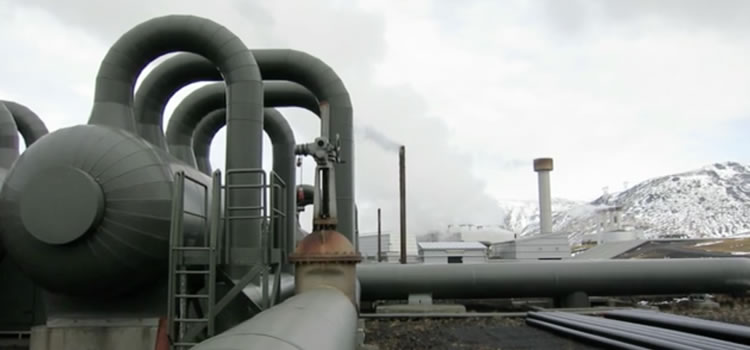
CCS-doorbraak op IJsland?
13 juni 2016 – Op IJsland lijken wetenschappers een veelbelovende ontdekking te hebben gedaan bij het ondergronds opslaan van CO2: in basaltlagen versteent het broeikasgas heel snel en voor eeuwig.
Uit een bericht van KIJK
‘(…) De omzetting van CO2 in carbonaat is onderdeel van een langlopend project CarbFix genaamd. De onderzoekers verzamelden de uitstoot van een IJslandse energiecentrale, mixten het met waterstofsulfide en water en spoten het vervolgens in basalt.
Het gas reageerde met het vulkanisch gesteente en vormde carbonaat – een materiaal dat erg op kalksteen lijkt. Wanneer koolstof eenmaal in carbonaat is veranderd, kan de koolstof niet meer het milieu in lekken. Tussen de 95 en 98 procent van de geïnjecteerde CO2 was gemineraliseerd in minder dan twee jaar. En dat is snel.
Dit klinkt veelbelovend, maar de onderzoekers zijn er nog lang niet. De energiecentrales die zij hebben gebruikt voor hun proef stoten slechts 5 procent CO2 uit van wat kolencentrales uitbraken. Daarnaast is de uitstoot van kolencentrales nog smeriger dan van geothermische centrales.
En last but not least IJsland is een vulkaaneiland. Maar waar halen andere landen grote voorraden basalt vandaan? Het project staat dus nog in de kinderschoenen. (…)’
 Inject, baby, inject!
Inject, baby, inject!
Uit Science
‘(…) Atmospheric CO2 can be sequestered by injecting it into basaltic rocks, providing a potentially valuable way to undo some of the damage done by fossil fuel burning. Matter et al. injected CO2 into wells in Iceland that pass through basaltic lavas and hyaloclastites at depths between 400 and 800 m. Most of the injected CO2 was mineralized in less than 2 years. Carbonate minerals are stable, so this approach should avoid the risk of carbon leakage. (…)’
Uit een bericht van het Lamont-Doherty Earth Observatory
‘(…) Scientists and engineers working at a major power plant in Iceland have shown for the first time that carbon dioxide emissions can be pumped into the earth and changed chemically to a solid within months—radically faster than anyone had predicted. The finding may help address a fear that so far has plagued the idea of capturing and storing CO2 underground: that emissions could seep back into the air or even explode out. A study describing the method appears this week in the journal Science.
The Hellisheidi power plant is the world’s largest geothermal facility; it and a companion plant provide the energy for Iceland’s capital, Reykjavik, plus power for industry, by pumping up volcanically heated water to run turbines. But the process is not completely clean; it also brings up volcanic gases, including carbon dioxide and nasty-smelling hydrogen sulfide.
Under a pilot project called Carbfix, started in 2012, the plant began mixing the gases with the water pumped from below and reinjecting the solution into the volcanic basalt below. In nature, when basalt is exposed to carbon dioxide and water, a series of natural chemical reactions takes place, and the carbon precipitates out into a whitish, chalky mineral. But no one knew how fast this might happen if the process were harnessed for carbon storage. Previous studies have estimated that in most rocks, it would take hundreds or even thousands of years. In the basalt below Hellisheidi, 95 percent of the injected carbon was solidified within less than two years.
“This means that we can pump down large amounts of CO2 and store it in a very safe way over a very short period of time,” said study co-author Martin Stute, a hydrologist at Columbia University’s Lamont-Doherty Earth Observatory. (…)
The 2014 report of the Intergovernmental Panel on Climate Change suggests that without such technology, it may not be possible to limit global warming adequately. But up to now, projects have made little progress. (…)’
‘Groundbreaking’
Uit een artikel van de NRC
‘(…) [Chemisch technoloog Earl Goetheer van TNO:] „De koolstof is geologisch gevangen, en blijft voor eeuwig zitten.” (…)
Bij het experiment bleek dat 95 procent van het in de ondergrond geïnjecteerde CO2 binnen twee jaar was verdwenen. „De meest plausibele verklaring is dat het als calciumcarbonaat is opgeslagen, hoewel ze niet veel details geven over wat daar beneden gebeurt”, zegt marien bioloog Francesc Montserrat van het Koninklijk Nederlands Instituut voor Onderzoek der Zee. Toch noemt hij het IJslandse experiment „ groundbreaking ”. (…) Eerste auteur van het Science-artikel Jürg Matter van de universiteit van Southampton laat via e-mail weten dat ze nu op 17 dollar per ton CO2 uitkomen. Normaal ligt de kostprijs tussen de 40 en 50 dollar. Goetheer beaamt dat. (…) Volgens Matter zijn er wereldwijd in theorie genoeg basaltlagen om alle menselijke CO2-uitstoot in op te slaan. (…)’
Video Lamont-Doherty Earth Observatory (5’01”)
Bronnen
Kijk,12 juni 2016: Koolstofdioxide verandert razendsnel in steen
Science, 10 juni 2016: Rapid carbon mineralization for permanent disposal of anthropogenic carbon dioxide emissions
Lamont-Doherty Earth Observatory, 9 juni 2016: In a First, Iceland Power Plant Turns Carbon Emissions to Stone
NRC, 11 juni 2016: Gevangen in basalt (via Blendle)
Foto’s: Lamont-Doherty Earth Observatory



